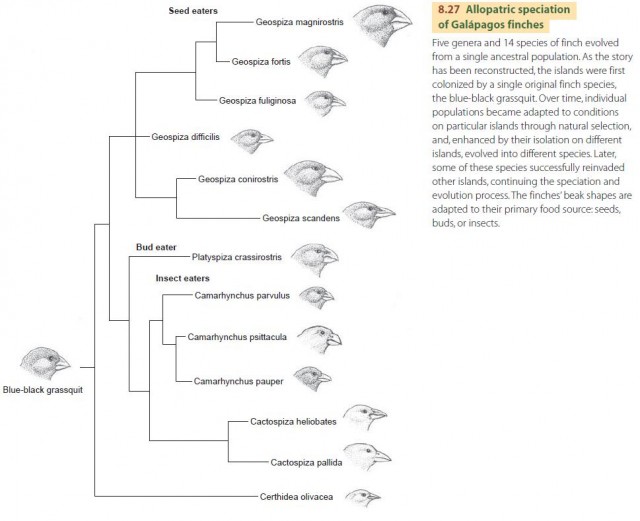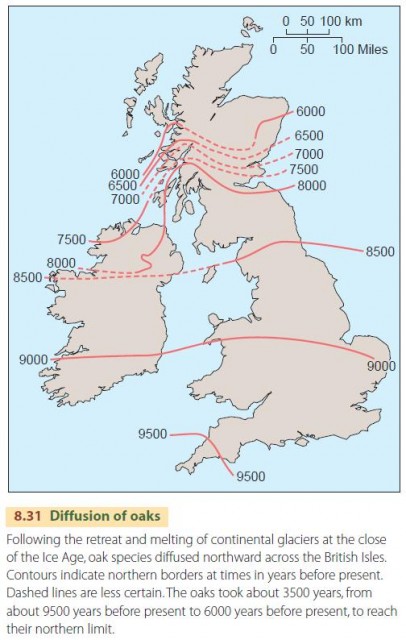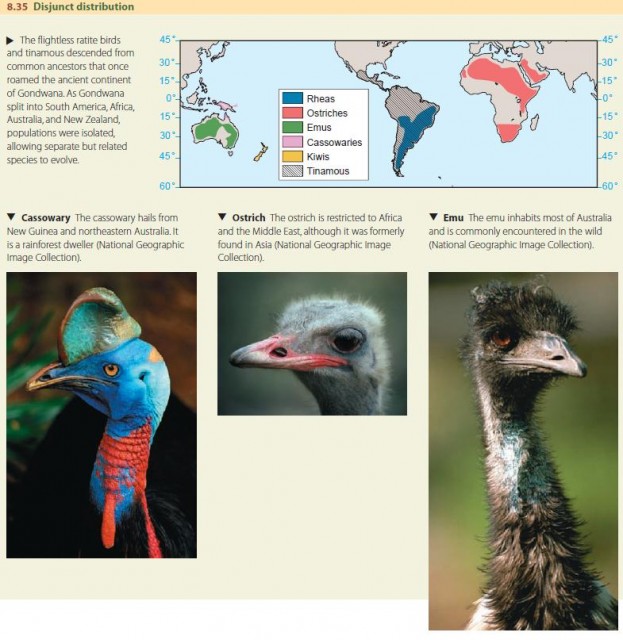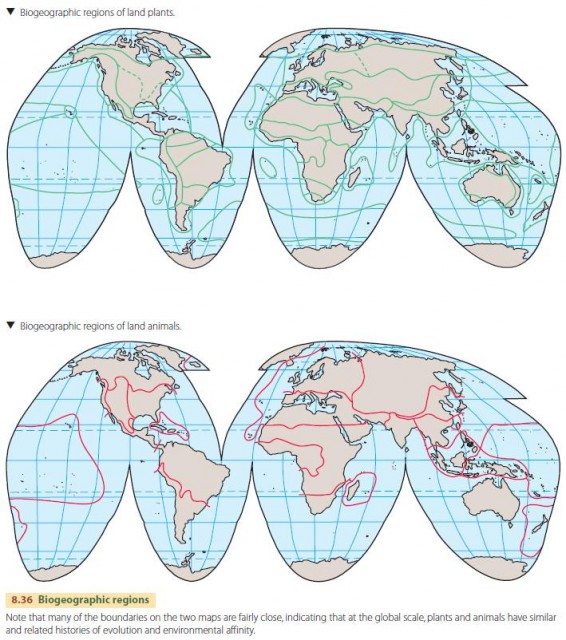Historical Biogeography
Thus far, we've looked at ecological processes that produce biogeographic patterns at local and regional spatial scales. We now turn to patterns at continental and global scales that develop over longer time periods. Historical biogeography focuses on how these spatial distribution patterns arise over space and time through four key processes: evolution, speciation, extinction, and dispersal.
EVOLUTION
An astonishing number of organisms exist on Earth, each adapted to the ecosystem in which it carries out its life cycle. About 40,000 species of microorganisms, 350,000 species of plants, and 2.2 million species of animals, including some 800,000 insect species, have been described and identified. This is probably only a fraction of the number of species found on Earth. How has life gained this astonishing diversity?
Through the process of evolution, the environment itself has acted on organisms to create this diversity. You've probably heard of Sir Charles Darwin, whose monumental biological work, The Origin of Species by Means of Natural Selection, was published in 1859. Through exhaustive studies, Darwin showed that all life possesses variation—the differences that arise between parent and offspring. He proposed that the environment acts on variation in organisms in much the same way that a plant or an animal breeder does, picking out the individuals with qualities that are best suited to their environment. These individuals are more likely to live longer, propagate, and pass on their useful qualities.
Darwin termed this survival and reproduction of the fittest natural selection. He saw that, when acted upon by natural selection through time, variation could bring about the formation of new species whose individuals differed greatly from their ancestors.
But how and why does this variation occur in the first place? Although Darwin couldn't provide an explanation, we now know the answer. Variation comes from two interacting sources: mutation and recombination. A reproductive cell's genetic material (DNA, or deoxyribonucleic acid) can mutate when the cell is exposed to heat, ionizing radiation, or certain types of chemical agents. Chemical bonds in the DNA are broken and reassembled. Most mutations either have no effect or are harmful. But a small proportion of mutations have a positive effect on the individual's genetic makeup. If that positive effect makes the individual organism more likely to survive and reproduce, then the altered gene is likely to survive as well and be passed on to offspring.
Recombination describes the process by which an offspring receives two slightly different copies, or alleles, of each gene from its parents. One allele may be dominant and suppress the other, or the two alleles may act simultaneously. Because each individual receives two alleles of each gene, and there are typically tens of thousands of genes in an organism, the possible number of genetic combinations is very large. Thus, recombination provides a constant source of variation that acts to make every offspring slightly different from the next.
SPECIATION
Mutations change the nature of species through time. But just what is a species? For our purposes, we can define a species (plural, species) as a collection of individuals capable of interbreeding to produce fertile offspring. A genus (plural, genera) is a collection of closely related species that share a similar genetic evolutionary history.
Speciation is the process by which species are differentiated and maintained.
Actually, speciation is not a single process. It arises from a number of component processes acting together through time. We've already looked at two of these: mutation and natural selection.
A third speciation process is genetic drift. Chance mutations that don't have any particular benefit can still change the genetic composition of a breeding population until it diverges from other populations. Genetic drift is a weak factor in large populations. But in small populations, such as a colony of a few pioneers in a new habitat, random mutations are more likely to be preserved. Gene flow is the opposite process. Evolving populations exchange alleles as individuals move among populations, keeping the gene pool uniform.
Speciation often occurs when populations become isolated from one another, so there's no gene flow between them. This geographic isolation can happen in several ways. For example, geologic forces may uplift a mountain range that separates a population into two different subpopulations by a climatic barrier. Or a chance long-distance dispersal may establish a new population far from the main one. These are examples of allopatric speciation. As genetic drift and natural selection proceed, the populations gradually diverge and eventually lose the ability to interbreed.

The evolution of finch species on the Galapagos Islands is a classic example of allopatric speciation (Figure 8.27). Charles Darwin visited this cluster of five major volcanic islands and nine lesser ones, located about 800 km (500 mi) from the coast of Ecuador, and they inspired his ideas about evolution. The famous giant tortoises of the Galapagos are another example. Each of the larger islands bears at least one distinctly different population of these reptiles. Like the finches, they are believed to be evolved from a single ancestral stock that colonized the island chain and then diverged into unique types.
Sympatric speciation, by contrast, only occurs within a larger population. Imagine a species that has two different primary food sources. Eventually, mutations will arise that favor one food source over the other. For example, birds could develop two different lengths or shapes of beak, with one beak type better adapted for eating fruit and the other better suited to seeds. As these mutations are exposed to natural selection, they will produce two different populations, each adapted to its own food source. Eventually, the populations can become separate species.
Another mechanism of sympatric speciation that is quite important in plants is polyploidy. Normal organisms have two sets of genes and chromosomes—that is, they are diploid. Through accidents in the reproduction process, two closely related species can cross in such a way that the offspring has both sets of genes from both parents. These tetraploids are fertile but can't reproduce with the populations from which they arose, and so they are instantly isolated as new species. About 70 to 80 percent of higher plant species probably arose in this fashion.
EXTINCTION
Over geologic time, all species are doomed to extinction. When conditions change more quickly than populations can evolve new adaptations, population size falls. When that happens, the population is more vulnerable to chance occurrences, such as a fire, a rare climatic event, or an outbreak of disease. Ultimately, the population is wiped out.
Some extinctions occur very rapidly, particularly those induced by human activity, such as in the classic example of the passenger pigeon. Rare but extreme events can also cause extinctions. Strong evidence suggests that the Earth was struck by a large meteorite about 65 million years ago, wiping out the dinosaurs and many other groups of terrestrial and marine organisms. The impact sent huge volumes of dust into the atmosphere that choked off sunlight globally for several years and froze many plants and animals to death.
DISPERSAL
Nearly all types of organisms can move from a location of origin to new sites. Often this dispersal is confined to one life stage, as in the dispersal of higher plants as seeds. Even for animals, there is often a developmental stage when the animals are more likely to move from one site to the next.
Normally, dispersal doesn't change the species' geographic range. Seeds fall near their sources, and animals seek out nearby habitats to which they are adjusted. Dispersal is thus largely a method for gene flow that helps to encourage the cross-breeding of organisms throughout a population. When land is cleared or new land is formed, dispersal moves colonists into the new environment, as we saw when we discussed succession. Species also disperse by diffusion—slowly extending their range from year to year. An example of diffusion is the northward colonization of the British Isles by oaks at the end of the Ice Age (Figure 8.31).

A rare, long-distance dispersal event can be very significant, as we saw with the Galapagos finches. Some species, such as the ubiquitous coconut, are especially well adapted to long-distance dispersal. Among the animals, birds, bats, and insects are frequent longdistance travelers. Generally, nonflying mammals, freshwater fishes, and amphibians are less likely to make long leaps, with rats and tortoises the exceptions.
Dispersal often means surmounting barriers. That might mean bridging an ocean or an ice sheet by an unlikely accident. But other barriers are not so obvious. For example, the basin and range country of Utah, Nevada, and California is a sea of desert with islands of forest. Birds and bats can easily move from one island to the next, but a small mammal would not be likely to cross the desert sea under its own power. In this case, it's beyond the species' physiological limits to cross the barrier. But there may be ecological barriers as well—for example, a zone filled with predators or a region occupied by strongly and successfully competing species.
There are also corridors that help dispersal. For example, Central America forms a present-day land bridge, connecting North and South America, that has been in place for about 3.5 million years. Other corridors existed in the recent past. The Bering Strait region between Alaska and easternmost Siberia was dry land during the early Cenozoic Era (about 60 million years ago) and during the Ice Age, when sea level dropped by more than 100 m (325 ft). Many plant and animal species of Asia are known to have crossed this bridge and then spread southward into the Americas. One notable migrant species of the last continental glaciation was the aboriginal human, and evidence suggests that these skilled hunters caused the extinction of many of the large animals, including wooly mammoths and ground sloths, that disappeared from the Americas about 10,000 years ago.
DISTRIBUTION PATTERNS
Over time, evolution, speciation, extinction, and dispersal have distributed many species across the Earth, creating a number of spatial distribution patterns. An endemic species is found in one region or location and nowhere else. An endemic distribution can arise in two ways—the species simply stays within a small range of its original location, or it contracts from a broader range. Some endemic species are ancient relics of biological strains that have otherwise gone extinct.
In contrast to endemics are cosmopolitan species, which are distributed very widely. Very small organisms, or organisms with very small propagating forms, are often cosmopolitan because they can be distributed widely by atmospheric and oceanic circulations. Disjunction is another interesting pattern, in which one or more closely related species are found in widely separated regions.
BIOGEOGRAPHIC REGIONS
When we examine the spatial distributions of species on a global scale, we find common patterns. Closely related species tend to be nearby or to occupy similar regions. But larger groups of organisms, such as families and orders, often have disjunct distribution patterns. For example, the South America– Africa–Australia–New Zealand pattern for the ratite birds, described in Figure 8.35, also fits the distribution of many other ancient families of plants and animals. This reflects their common ancestry on the supercontinent of Gondwana, which existed about 210 million years ago and then gradually split apart. Global climate also plays an important role. Often, members of the same lineage have similar adaptations to environment, and so they are found in similar climatic regions.

We can define biogeographic regions as areas in which the same or closely related plants and animals tend to be found together. When we cross the boundary between two biogeographic regions, we pass from one group of distinctive plants and animals to another. Figure 8.36 shows the major biogeographic regions for plants and animals.
